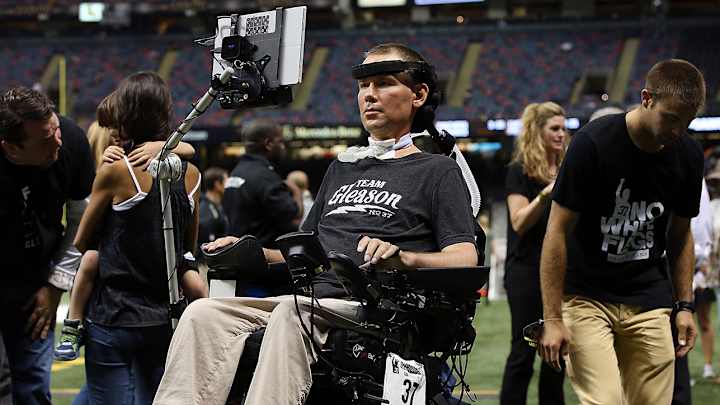Microsoft helps Steve Gleason sign autographs with his eyes

Read about the latest sports tech news, innovations, ideas and products that impact players, fans and the sports industry at SportTechie.com.
Five years after his diagnosis with ALS and 10 years since his memorable blocked punt against the Falcons, Steve Gleason can sign autographs again.
Gleason and the organization he founded, Answer ALS, are teaming up with creative agency KBS, Microsoft and the NFL to launch a “Game Changing Auction” of the signed memorabilia to raise money for ALS research. One of the items currently being auctioned is a jersey that was signed by Gleason using the first-ever robotic arm controlled by eyesight. The first jersey raised $2,000 and received 65 bids.
“KBS came up with the idea of focusing on Steve and isolating a game-changing moment (for the event),” said Clare Durrett, associate director of Team Gleason, the foundation Gleason started in 2013. “And in doing so, they asked us if there was a way Steve could autograph a jersey, and we said, ‘No. He’s completely paralyzed, and his wife helps him sign by holding his hand.’ We just started thinking about, ‘Well, Microsoft does a lot of really crazy amazing things for us. Let’s just ask them if they can come up with a way for Steve to use his eyes to autograph a jersey.'”

Subscribe to the
SportTechie Newsletter
- Hair plug addiction almost cost Joe Buck his career
- Manfred: Robot umps could be feasible
- Introducing the combo water bottle-foam roller
Within 24 hours, Microsoft came back to Durrett with a plan of execution.
Because Gleason lost all motor skills as a result of ALS, which affects the function of the nerves and muscles, Microsoft created a prototype using the same Surface Pro Eye-Track technology that Gleason currently uses to talk and maneuver his wheelchair.
Team Gleason has been working with Microsoft since Gleason was featured in the company’s first Super Bowl commercial. After that commercial, the foundation and Microsoft began to explore forms of technology that help people with severe physical limitations due to ALS.
The mechanical arm doesn’t look like a prosthetic human arm, but rather a metal rod with a pen on the end that Gleason controls with his eyes. He traces the outline of his signature with his eyes, and then the pen follows the track of his gaze.
Costs of the robotic arm were intentionally kept to roughly $400 in an attempt to make the technology affordable for those who need it. According to the ALS Association, more than 6,000 people in the U.S. are diagnosed with ALS each year. The life expectancy of ALS is about two to five years from diagnosis.
When Gleason signed the jersey to be auctioned using Microsoft’s technology in the Superdome, he was positioned in almost the exact spot where he blocked the punt 10 years prior. The current jersey auction closes Oct. 13.
